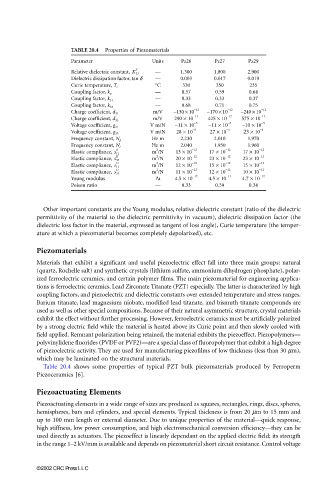Page 583 - The Mechatronics Handbook
P. 583
0066_Frame_C20 Page 53 Wednesday, January 9, 2002 5:49 PM
TABLE 20.4 Properties of Piezomaterials
Parameter Units Pz26 Pz27 Pz29
T
Relative dielectric constant, K 33 — 1.300 1.800 2.900
Dielectric dissipation factor, tan δ — 0.003 0.017 0.019
°C 330 350 235
Curie temperature, T c
— 0.57 0.59 0.64
Coupling factor, k p
— 0.33 0.33 0.37
Coupling factor, k 31
— 0.68 0.71 0.75
Coupling factor, k 33
m/V −130 × 10 −12 −170 × 10 −12 −240 × 10 −12
Charge coefficient, d 31
m/V 290 × 10 −12 425 × 10 −12 575 × 10 −12
Charge coefficient, d 33
V m/N −11 × 10 −3 −11 × 10 −3 −10 × 10 −3
Voltage coefficient, g 31
V m/N 28 × 10 −3 27 × 10 −3 23 × 10 −3
Voltage coefficient, g 33
Hz m 2.230 2.010 1.970
Frequency constant, N p
Hz m 2.040 1.950 1.960
Frequency constant, N t
E 2 −12 −12 −12
Elastic compliance, s 11 m /N 13 × 10 17 × 10 17 × 10
E 2 −12 −12 −12
Elastic compliance, s 33 m /N 20 × 10 23 × 10 23 × 10
D 2 −12 −12 −12
Elastic compliance, s 11 m /N 12 × 10 15 × 10 15 × 10
D 2 −12 −12 −12
Elastic compliance, s 33 m /N 11 × 10 12 × 10 10 × 10
Young modulus Pa 4.5 × 10 −12 4.5 × 10 −12 4.7 × 10 −12
Poison ratio — 0.33 0.39 0.34
Other important constants are the Young modulus, relative dielectric constant (ratio of the dielectric
permittivity of the material to the dielectric permittivity in vacuum), dielectric dissipation factor (the
dielectric loss factor in the material, expressed as tangent of loss angle), Curie temperature (the temper-
ature at which a piezomaterial becomes completely depolarized), etc.
Piezomaterials
Materials that exhibit a significant and useful piezoelectric effect fall into three main groups: natural
(quartz, Rochelle salt) and synthetic crystals (lithium sulfate, ammonium dihydrogen phosphate), polar-
ized ferroelectric ceramics, and certain polymer films. The main piezomaterial for engineering applica-
tions is ferroelectric ceramics, Lead Zirconate Titanate (PZT) especially. The latter is characterized by high
coupling factors, and piezoelectric and dielectric constants over extended temperature and stress ranges.
Barium titanate, lead magnesium niobate, modified lead titanate, and bismuth titanate compounds are
used as well as other special compositions. Because of their natural asymmetric structure, crystal materials
exhibit the effect without further processing. However, ferroelectric ceramics must be artificially polarized
by a strong electric field while the material is heated above its Curie point and then slowly cooled with
field applied. Remnant polarization being retained, the material exhibits the piezoeffect. Piezopolymers—
polyvinylidene fluorides (PVDF or PVF2)—are a special class of fluoropolymer that exhibit a high degree
of piezoelectric activity. They are used for manufacturing piezofilms of low thickness (less than 30 µm),
which may be laminated on the structural materials.
Table 20.4 shows some properties of typical PZT bulk piezomaterials produced by Ferroperm
Piezoceramics [6].
Piezoactuating Elements
Piezoactuating elements in a wide range of sizes are produced as squares, rectangles, rings, discs, spheres,
hemispheres, bars and cylinders, and special elements. Typical thickness is from 20 µm to 15 mm and
up to 100 mm length or external diameter. Due to unique properties of the material—quick response,
high stiffness, low power consumption, and high electromechanical conversion efficiency—they can be
used directly as actuators. The piezoeffect is linearly dependant on the applied electric field; its strength
in the range 1–2 kV/mm is available and depends on piezomaterial short circuit resistance. Control voltage
©2002 CRC Press LLC

